2019年翻译资格考试三级笔译练习题:沙漠化
- 格式:doc
- 大小:45.89 KB
- 文档页数:4
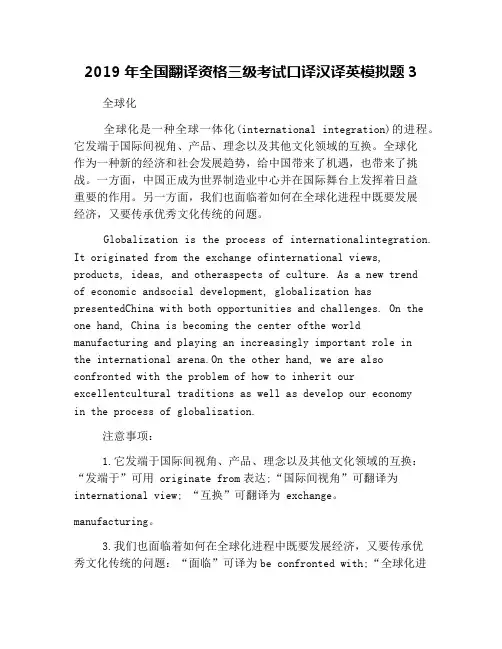
2019年全国翻译资格三级考试口译汉译英模拟题3全球化全球化是一种全球一体化(international integration)的进程。
它发端于国际间视角、产品、理念以及其他文化领域的互换。
全球化作为一种新的经济和社会发展趋势,给中国带来了机遇,也带来了挑战。
一方面,中国正成为世界制造业中心并在国际舞台上发挥着日益重要的作用。
另一方面,我们也面临着如何在全球化进程中既要发展经济,又要传承优秀文化传统的问题。
Globalization is the process of internationalintegration. It originated from the exchange ofinternational views, products, ideas, and otheraspects of culture. As a new trendof economic andsocial development, globalization has presentedChina with both opportunities and challenges. On the one hand, China is becoming the center ofthe world manufacturing and playing an increasingly important role inthe international arena.On the other hand, we are also confronted with the problem of how to inherit our excellentcultural traditions as well as develop our economyin the process of globalization.注意事项:1.它发端于国际间视角、产品、理念以及其他文化领域的互换:“发端于”可用 originate from表达;“国际间视角”可翻译为international view; “互换”可翻译为 exchange。
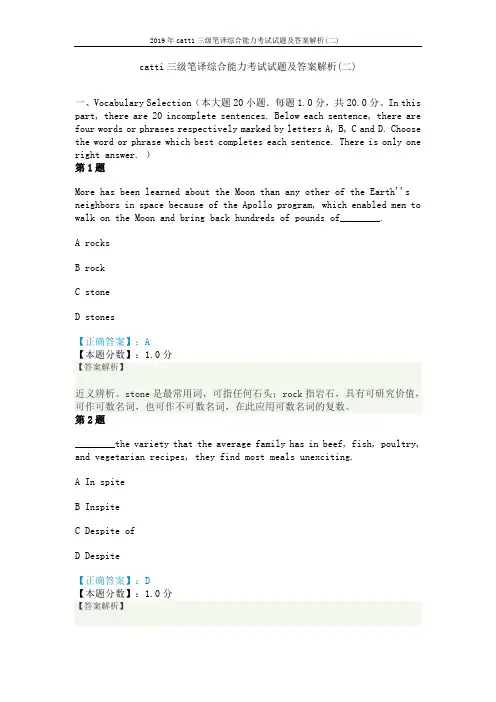
catti三级笔译综合能力考试试题及答案解析(二)一、Vocabulary Selection(本大题20小题.每题1.0分,共20.0分。
In this part, there are 20 incomplete sentences. Below each sentence, there are four words or phrases respectively marked by letters A, B, C and D. Choose the word or phrase which best completes each sentence. There is only one right answer. )第1题More has been learned about the Moon than any other of the Earth''s neighbors in space because of the Apollo program, which enabled men to walk on the Moon and bring back hundreds of pounds of________.A rocksB rockC stoneD stones【正确答案】:A【本题分数】:1.0分【答案解析】近义辨析。
stone是最常用词,可指任何石头;rock指岩石,具有可研究价值,可作可数名词,也可作不可数名词,在此应用可数名词的复数。
第2题________the variety that the average family has in beef, fish, poultry, and vegetarian recipes, they find most meals unexciting.A In spiteB InspiteC Despite ofD Despite【正确答案】:D【本题分数】:1.0分【答案解析】习语辨析。
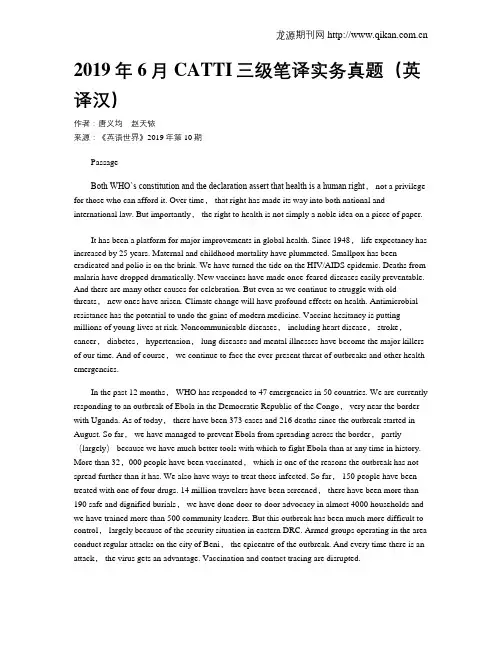
2019年6月CATTI三级笔译实务真题(英译汉)作者:唐义均赵天铱来源:《英语世界》2019年第10期PassageBoth WHO’s constitution and the declaration assert that health is a human right, not a privilege for those who can afford it. Over time, that right has made its way into both national and international law. But importantly, the right to health is not simply a noble idea on a piece of paper.It has been a platform for major improvements in global health. Since 1948, life expectancy has increased by 25 years. Maternal and childhood mortality have plummeted. Smallpox has been eradicated and polio is on the brink. We have turned the tide on the HIV/AIDS epidemic. Deaths from malaria have dropped dramatically. New vaccines have made once-feared diseases easily preventable. And there are many other causes for celebration. But even as we continue to struggle with old threats, new ones have arisen. Climate change will have profound effects on health. Antimicrobial resistance has the potential to undo the gains of modern medicine. Vaccine hesitancy is putting millions of young lives at risk. Noncommunicable diseases, including heart disease, stroke,cancer, diabetes, hypertension, lung diseases and mental illnesses have become the major killers of our time. And of course, we continue to face the ever-present threat of outbreaks and other health emergencies.In the past 12 months, WHO has responded to 47 emergencies in 50 countries. We are currently responding to an outbreak of Ebola in the Democratic Republic of the Congo, very near the border with Uganda. As of today, there have been 373 cases and 216 deaths since the outbreak started in August. So far, we have managed to prevent Ebola from spreading across the border, partly (largely) because we have much better tools with which to fight Ebola than at any time in history. More than 32,000 people have been vaccinated, which is one of the reasons the outbreak has not spread further than it has. We also have ways to treat those infected. So far, 150 people have been treated with one of four drugs. 14 million travelers have been screened, there have been more than 190 safe and dignified burials, we have done door-to-door advocacy in almost 4000 households and we have trained more than 500 community leaders. But this outbreak has been much more difficult to control, largely because of the security situation in eastern DRC. Armed groups operating in the area conduct regular attacks on the city of Beni, the epicentre of the outbreak. And every time there is an attack, the virus gets an advantage. Vaccination and contact tracing are disrupted.Health security and health systems are the two sides of the same coin. The best long-term investment in protecting and promoting the right to health is to invest in stronger health systems. Because there is simply no other way to achieve universal health coverage and the Sustainable Development Goals (SDGs) than primary health care, with a focus on health promotion and disease prevention. But it will also require WHO and the global health community to work in a much more integrated and coherent way. That’s why WHO and 10 other international health agencies have agreed to work together on a Global Action Plan for Healthy Lives and Well-Being. The plan has three strategic approaches: integrate, accelerate and account1. First, we have committed to integrate many of our processes to increase our collective efficiency. Second, we have committed to accelerate progress by identifying areas of work in which we can truly bend the curve and make more rapid progress towards the health-related SDGs—like research and development, data and sustainable financing.2 And third, we have committed to keep each other accountable, both to the people we serve, and to the donors and partners who expect results from the resources they give us.【参考译文】世卫组织的章程和宣言均宣称,健康是一项人权,而不是那些有钱维持身体健康的人群的特权。

笔译三级实务模拟试卷19(题后含答案及解析) 题型有:1. English-Chinese Translation 2. Chinese-English TranslationPART 1 English-Chinese Translation (60 points)Translate the following passage into Chinese. The time for this part is 120 minutes.1.As The Economist went to press, Steve Fossett, a famed and fearless aviator who went missing over the Nevada desert on September 3rd, had not been found. But it was not for want of trying. Mr. Fossett has been the subject of one of the most intensive civilian manhunts in history—and also, fittingly, one of the most technological. Besides the usual panoply of search-and-rescue aircraft deployed by America’s Civil Air Patrol, which wound down its search on September 17th, a different sort of search effort is being conducted online, using satellite photographs. These pictures of the search area are being provided by two firms that supply information to Google Earth: GeoEye and DigitalGlobe. The search itself is being co-ordinated by a corner of the Amazon empire called Mechanical Turk. This is an online job market which farms out tasks that humans are good at, but for which software is poorly equipped, like labeling images and transcribing speech. For the Fossett hunt, volunteers comb through the images and flag any that include what might be a plane or its wreckage. Among those who keep track of slightly less high-profile missing-person cases, the story will be strikingly familiar. In January Jim Gray, one of Microsoft’s programming gurus, disappeared while sailing near San Fransisco Bay. Mr. Gray was as big a celebrity among computer geeks as Mr. Fossett is among thrill-seekers, and the story played out in the same way. A friend at Amazon, Werner V ogels, got in touch with DigitalGlobe, and the firm provided thousands of images. Within four days, Mechanical Turk was hosting the images and more than 10, 000 volunteers were sifting through them—though to no avail, as Mr. Gray was never found. Mechanical Turk’s director, Peter Cohen, says that now the search protocol has been established, conducting such “distributed” searches is much easier. The limiting factor is the satellite imagery—which obviously has to be up-to-date. At the moment, only three commercial satellites provide the kind of resolution that can help in efforts like the Fossett hunt. The firms that own them have governments as their main customers. This makes search-and-rescue imaging a secondary concern. That looks set to change, though. DigitalGlobe launched its second satellite, WorldView-1, on September 18th, and will launch a third late next year. GeoEye will launch its second next spring. This machine should set a new record for commercial satellite resolution; just 41cm(though that will still not be quite good enough to spot people as well as planes). In total, these launches will double the amount of satellite time that can be dedicated to requests for instant pictures. Cost, however, is less of a problem. Area such as the Nevada desert and San Francisco Bay are not strategic, so taking photographs of them does not displace paying customers—indeed, DigitalGlobe is not charging for the pictures being used in the Fossett hunt. With theextra capacity provided by the new satellites, the cost will drop even further. And Mr. Cohen is convinced that the internet will always come up with the few thousand volunteers needed to scour the resulting images. Far from being the invasion of privacy it was recendy claimed to be, the technology behind Google Earth may in time grow to be a standard search-and-rescue tool.正确答案:土耳其搜救据《经济学家》报道,著名而勇敢的飞行员史蒂夫-佛赛特于9月3日在飞越内华达沙漠的途中失踪,至今仍下落不明。
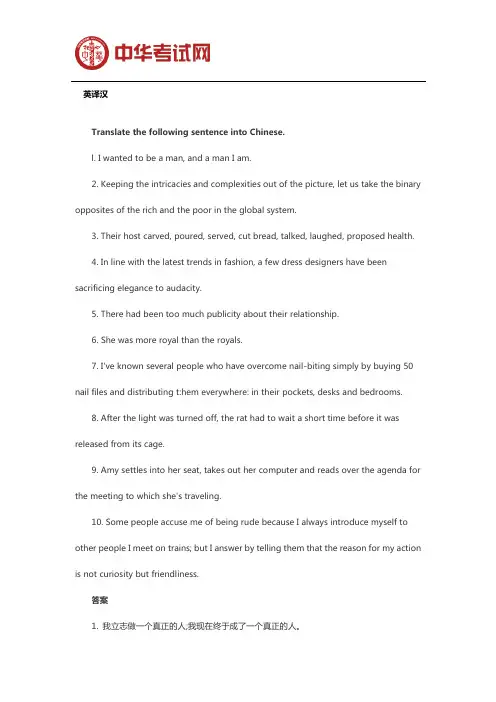
英译汉Translate the following sentence into Chinese.l. I wanted to be a man, and a man I am.2. Keeping the intricacies and complexities out of the picture, let us take the binary opposites of the rich and the poor in the global system.3. Their host carved, poured, served, cut bread, talked, laughed, proposed health.4. In line with the latest trends in fashion, a few dress designers have been sacrificing elegance to audacity.5. There had been too much publicity about their relationship.6. She was more royal than the royals.7. I've known several people who have overcome nail-biting simply by buying 50 nail files and distributing t:hem everywhere: in their pockets, desks and bedrooms.8. After the light was turned off, the rat had to wait a short time before it was released from its cage.9. Amy settles into her seat, takes out her computer and reads over the agenda for the meeting to which she's traveling.10. Some people accuse me of being rude because I always introduce myself to other people I meet on trains; but I answer by telling them that the reason for my action is not curiosity but friendliness.答案1. 我立志做一个真正的人;我现在终于成了一个真正的人。
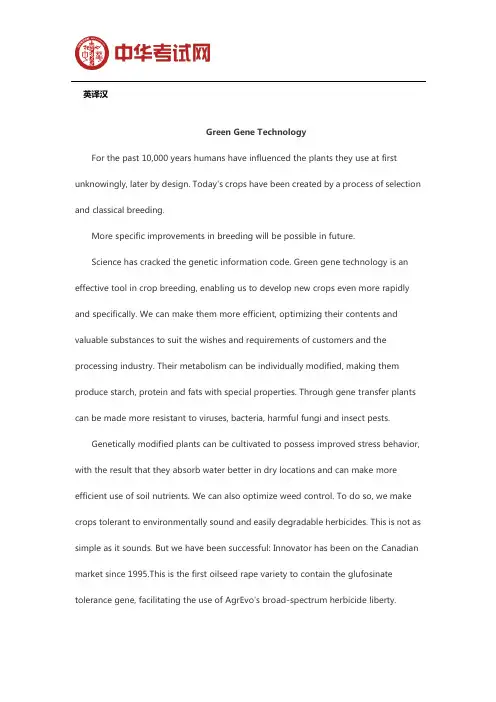
英译汉Green Gene TechnologyFor the past 10,000 years humans have influenced the plants they use at first unknowingly, later by design. Today's crops have been created by a process of selection and classical breeding.More specific improvements in breeding will be possible in future.Science has cracked the genetic information code. Green gene technology is an effective tool in crop breeding, enabling us to develop new crops even more rapidly and specifically. We can make them more efficient, optimizing their contents and valuable substances to suit the wishes and requirements of customers and the processing industry. Their metabolism can be individually modified, making them produce starch, protein and fats with special properties. Through gene transfer plants can be made more resistant to viruses, bacteria, harmful fungi and insect pests.Genetically modified plants can be cultivated to possess improved stress behavior, with the result that they absorb water better in dry locations and can make more efficient use of soil nutrients. We can also optimize weed control. To do so, we make crops tolerant to environmentally sound and easily degradable herbicides. This is not as simple as it sounds. But we have been successful: Innovator has been on the Canadian market since 1995.This is the first oilseed rape variety to contain the glufosinate tolerance gene, facilitating the use of AgrEvo's broad-spectrum herbicide liberty.We are committed to green gene technology, with which we aim to make crop breeding even more efficient and environmentally friendly. Before being brought on to the market these genetically modified plants are researched and tested for years until the questions posed regarding their safety have been answered. This is a great opportunity for us to realize our vision: the use of faster methods to breed varieties which will continue to provide us with sufficient food and raw materials in future. Our fossil reserves will soon be exhausted. Experts estimate that we only have enough oil for another 43 years and natural gas for less than 60.This means we must rethink and act accordingly, using new crop varieties to step up the move to replenishable sources of raw materials and energy. In other words, green gene technology is the key technology for sustainable agriculture.答案绿色基因技术在过去一万年中,人类改变了他们所利用的农作物。
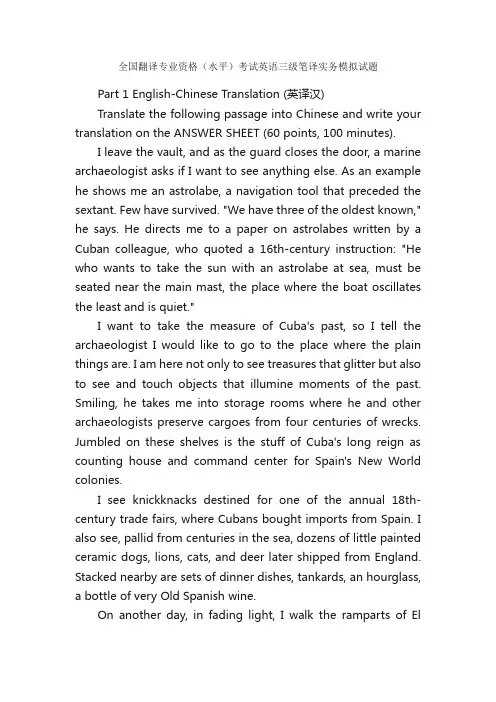
全国翻译专业资格(水平)考试英语三级笔译实务模拟试题Part 1 English-Chinese Translation (英译汉)Translate the following passage into Chinese and write your translation on the ANSWER SHEET (60 points, 100 minutes).I leave the vault, and as the guard closes the door, a marine archaeologist asks if I want to see anything else. As an example he shows me an astrolabe, a navigation tool that preceded the sextant. Few have survived. "We have three of the oldest known," he says. He directs me to a paper on astrolabes written by a Cuban colleague, who quoted a 16th-century instruction: "He who wants to take the sun with an astrolabe at sea, must be seated near the main mast, the place where the boat oscillates the least and is quiet."I want to take the measure of Cuba's past, so I tell the archaeologist I would like to go to the place where the plain things are. I am here not only to see treasures that glitter but also to see and touch objects that illumine moments of the past. Smiling, he takes me into storage rooms where he and other archaeologists preserve cargoes from four centuries of wrecks. Jumbled on these shelves is the stuff of Cuba's long reign as counting house and command center for Spain's New World colonies.I see knickknacks destined for one of the annual 18th-century trade fairs, where Cubans bought imports from Spain. I also see, pallid from centuries in the sea, dozens of little painted ceramic dogs, lions, cats, and deer later shipped from England. Stacked nearby are sets of dinner dishes, tankards, an hourglass, a bottle of very Old Spanish wine.On another day, in fading light, I walk the ramparts of ElMorro, its lighthouse standing tall over Havana's harbor. The old fortress, by day a warren of tourist stops, changes by night, looming deeper into the shadows of Havana's past. As torches light the darkness, I watch Cuban soldiers, costumed as 18th-century Spanish sentries, march along the ramparts of the Castillo de San Carlos and fire a cannon that salutes the end of day. In Spanish times the cannon signaled the closing of the city gates and the drawing of a great chain across the harbor. Now the nightly ritual keeps open the sea-lane of memory between colonial past and present nationhood.Near the waterfront of Old Havana stands the Palace of the Captains General. Once the headquarters of the Spanish bureaucracy that governed Cuba, the palace now is the Museum of the city. Light and shadow play along its walls of coral limestone. Royal palms rustle in its lust courtyard. Up a stone stairway a gallery leads to the spacious office of Eusebio Leal Spengler, historian of the city of Havana and preserver of its past.A slight, precise man in a well-tailored dark suit, he is the obvious ruler of the palace.We had hardly shaken hands before he began rapidly talking about Havana, a city he sees simultaneously in past and present. The jewels I had viewed in the vault were about to become part of the treasure he guards for Cuba. He has selected an old fort to be their new home. "This," he said with a sweep of his hand, "is the city that changed history. Because of a decision by PhilipⅡ all ships had to gather here to carry treasure back to Spain. And what treasure! Silk and aromatic wood from China, emeralds, silver."Part 2 Chinese-English Translation (汉译英)Translate the following passage into English and write your translation on the ANSWER SHEET (40 points, 80 minutes).中国海洋事业的发展海洋覆盖了地球表面的71%,是全球生命支持系统的一个基本组成部分,也是资源的宝库,环境的重要调节器。
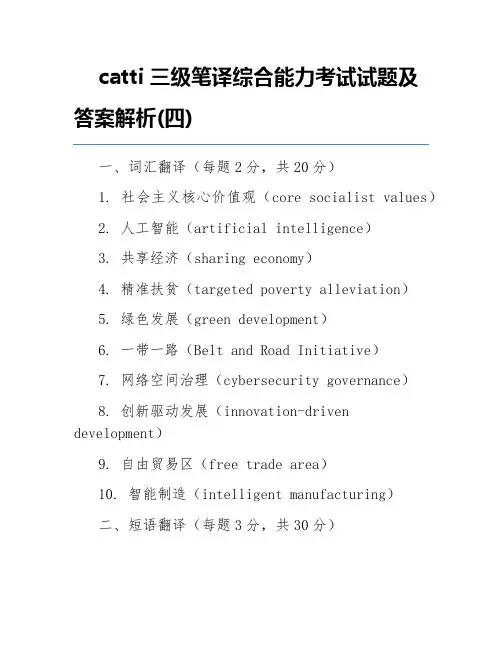
catti三级笔译综合能力考试试题及答案解析(四)一、词汇翻译(每题2分,共20分)1. 社会主义核心价值观(core socialist values)2. 人工智能(artificial intelligence)3. 共享经济(sharing economy)4. 精准扶贫(targeted poverty alleviation)5. 绿色发展(green development)6. 一带一路(Belt and Road Initiative)7. 网络空间治理(cybersecurity governance)8. 创新驱动发展(innovation-driven development)9. 自由贸易区(free trade area)10. 智能制造(intelligent manufacturing)二、短语翻译(每题3分,共30分)11. 全面建设社会主义现代化国家(comprehensively build a socialist modern country)12. 脱贫攻坚战(the fight against poverty)13. 互联网+(Internet+)14. 新型大国关系(a new type of major-country relationship)15. 人民币国际化(renminbi internationalization)16. 智慧城市(smart city)17. 社会主义核心价值观教育(education on core socialist values)18. 生态补偿(ecological compensation)19. 中华民族优秀传统文化(the excellent traditional Chinese culture)20. 公平竞争(fair competition)三、篇章翻译(40分)请将以下中文文章翻译成英文:随着我国经济社会发展,人们的生活方式发生了翻天覆地的变化。
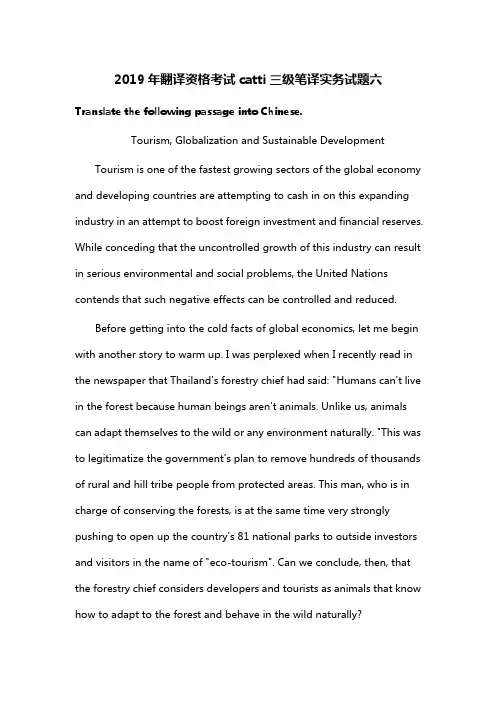
2019年翻译资格考试catti三级笔译实务试题六Translate the following passage into Chinese.Tourism, Globalization and Sustainable Development Tourism is one of the fastest growing sectors of the global economy and developing countries are attempting to cash in on this expanding industry in an attempt to boost foreign investment and financial reserves. While conceding that the uncontrolled growth of this industry can result in serious environmental and social problems, the United Nations contends that such negative effects can be controlled and reduced.Before getting into the cold facts of global economics, let me begin with another story to warm up. I was perplexed when I recently read in the newspaper that Thailand's forestry chief had said: "Humans can't live in the forest because human beings aren't animals. Unlike us, animals can adapt themselves to the wild or any environment naturally. "This was to legitimatize the government's plan to remove hundreds of thousands of rural and hill tribe people from protected areas. This man, who is in charge of conserving the forests, is at the same time very strongly pushing to open up the country's 81 national parks to outside investors and visitors in the name of "eco-tourism". Can we conclude, then, that the forestry chief considers developers and tourists as animals that know how to adapt to the forest and behave in the wild naturally?While authorities want to stop the access to forest lands and natural resources of village people, another group of people - namely tourism developers and tourists with lots of money to spend - are set to gain access to the area. While authorities believe that local people, who have often lived in the area for generations, are not capable of managing and conserving their land and natural resources - under a community forestry scheme for example - they believe they themselves in cooperation with the tourist industry can properly manage and conserve "nature" under a national eco-tourism plan. Taking the above quote seriously, cynics may be tempted to say there is obviously a gap between "human rights" and "animal rights".How is this story linked to globalization? First of all, that humans cannot live in the forest is - of course - not a Thai concept. It is a notion of Western conservation ideology - an outcome of the globalization of ideas and perceptions. Likewise, that eco-tourism under a "good management" system is beneficial to local people and nature is also a Western concept that is being globalized. In fact, Thailand's forestry chief thinks globally and acts locally. A lesson that can be learned from this is that the slogan "Think Globally, Act Locally" that the environmental movements have promoted all the years, has not necessarily served to preserve the environment and safeguard local communities' rights, but has been co-opted and distorted by official agencies and privateindustries for profit-making purposes. The tourism industry is demonstrating this all too wellMany developing countries, facing debt burdens and worsening trade terms, have turned to tourism promotion in the hope that it brings foreign exchange and investment. Simultaneously, leading international agencies such as the World Bank, United Nations agencies and business organizations like the World Travel & Tourism Council (WTTC) have been substantially involved to make tourism a truly global industry.However, tourism in developing countries is often viewed by critics as an extension of former colonial conditions because from the very beginning, it has benefited from international economic relationships that structurally favor the advanced capitalist countries in the North. Unequal trading relationships, dependence on foreign interests, and the division of labor have relegated Door countries in the South to becoming tourism recipients and affluent countries in the North to the position of tourism generators, with the latter enjoying the freedom from having to pay the price for the meanwhile well-known negative impacts in destinations.答案旗游、全球化与可持续发展旅游是全球经济中一个快速增长的领域,因而发展中国家正努力从这一快速增长的产业中获利,以促进海外投资、增加金融储备。

英译汉In today’s interconnected world, culture's power to transformsocieties is clear. Its diverse manifestations –from our cherished historicmonuments and museums to traditional practices and contemporary art forms –enrich our everyday lives in countless ways. Heritage constitutes a source ofidentity and cohesion for communities disrupted by bewildering change andeconomic instability. Creativity contributes to building open, inclusive andpluralistic societies. Both heritage and creativity lay the foundations forvibrant, innovative and prosperous knowledge societies.What is culture? Culture is who we are and what shapes ouridentity. No development can be sustainable without including culture. UNESCOensures that the role of culture is recognized through a majority of theSustainable Development Goals (SDGs), including those focusing on qualityeducation, sustainable cities, the environment, economic growth, sustainableconsumption and production patterns, peaceful and inclusive societies, genderequality and food security. UNESCO is convinced that no development can besustainable without a strong culture component.To ensure that culture takes its rightful place in developmentstrategies and processes, UNESCO has adopted a three-pronged approach: itspearheads worldwide advocacy for culture and development, while engaging withthe international community to set clear policies and legal frameworks andworking on the ground tosupport governments and local stakeholders tosafeguard heritage, strengthen creative industries and encourage cultural pluralism.Today, creativity is emerging as one of the most promisingavenues for changing how we see cities. Whether by revitalizing the localeconomy, rethinking transport or housing policies, reclaiming urban spaces, oropening up new horizons for young people, creativity is one of the drivingforces behind urban policies and initiatives. Cities worldwide are focusingtheir attention on the cultural and creative industries as an inspiration fortheir future.This vision is promoted by elected representatives and citypolicy-makers, who see it as a strategic lever for innovation when it comes totackling contemporary urban issues, whether on an economic, social orenvironmental front. More importantly, however, it is a vision shared by professionalsand citizens, who are taking action in their own neighborhoods and communitiesto build more sustainable and more human cities.This vision of creative urban governance is the driving forcebehind the UNESCO Creative Cities Programme and Network (联合国教科文组织创意城市网络). Since its creation in 2004,the Network has established itself as a strategic platform for promoting andsharing this new approach to sustainable cities. Through itsstandard-settingand operational actions, UNESCO has paved the way for demonstrating theessential role of creativity in urban sustainability, assisting national andlocal authorities and advocating this vision at an international level.Culture and creativity play a key role in sustainable urbandevelopment. They contribute to diversifying the economy and generating jobsbut they also enhance the quality of life of citizens by participating to acity’s social structure and cultural diversity.参考译文:在今天这个相互关联的世界里,文化改变社会的力量是显而易见的。
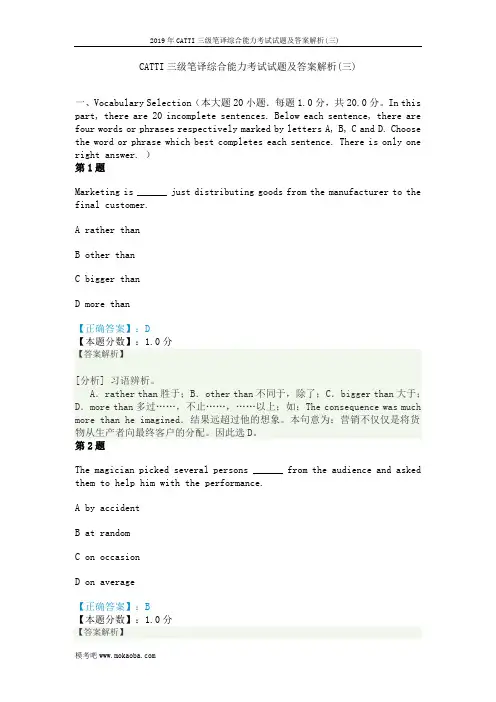
CATTI三级笔译综合能力考试试题及答案解析(三)一、Vocabulary Selection(本大题20小题.每题1.0分,共20.0分。
In this part, there are 20 incomplete sentences. Below each sentence, there are four words or phrases respectively marked by letters A, B, C and D. Choose the word or phrase which best completes each sentence. There is only one right answer. )第1题Marketing is ______ just distributing goods from the manufacturer to the final customer.A rather thanB other thanC bigger thanD more than【正确答案】:D【本题分数】:1.0分【答案解析】[分析] 习语辨析。
A.rather than胜于;B.other than不同于,除了;C.bigger than大于;D.more than多过……,不止……,……以上;如:The consequence was much more than he imagined.结果远超过他的想象。
本句意为:营销不仅仅是将货物从生产者向最终客户的分配。
因此选D。
第2题The magician picked several persons ______ from the audience and asked them to help him with the performance.A by accidentB at randomC on occasionD on average【正确答案】:B【本题分数】:1.0分【答案解析】[分析] 习语辨析。
2019年翻译考试catti三级笔译模拟练习题汉译英“一个国家,两种制度”是中国政府为实现国家和平统一而提出的基本国策。
按照“一国两制”方针,中国政府通过与英国政府的外交谈判成功解决历史遗留的香港问题,于1997年7月1日对香港恢复行使主权,实现了长期以来中国人民收回香港的共同愿望。
香港从此摆脱殖民统治,回到祖国怀抱,走上了与祖国内地优势互补、共同发展的宽广道路。
香港回归祖国后,“一国两制”由科学构想变成生动现实。
中央政府严格按照香港基本法办事,认真履行宪制责任,坚定支持香港特别行政区行政长官和政府依法施政;香港特别行政区依法实行高度自治,享有行政管理权、立法权、独立的司法权和终审权,继续保持原有的资本主义制度和生活方式不变,法律基本不变,继续保持繁荣稳定,各项事业全面发展。
“一国两制”在香港日益深入人心,得到包括香港同胞在内的全国人民的衷心拥护和国际社会的广泛好评“一国两制”作为一项新生事物,需要在实践中持续探索、开拓前进。
回顾总结“一国两制”在香港特别行政区的实践历程,全面准确地理解和贯彻“一国两制”方针政策, 有利于维护国家主权、安全和发展利益,有利于保持香港长期繁荣稳定,有利于继续推动“一国两制”实践沿着准确的轨道向前发展。
参考译文“One country, two systems” is a basic state policy the Chinese government has adopted to realize the peaceful reunification of the country. Following this principle, the Chinese government successfully solved the question of Hong Kong through diplomatic negotiations with the British government, and resumed the exercise of sovereignty over Hong Kong on July 1, 1997, fulfilling the common aspiration of the Chinese people for the recovery of Hong Kong. As a result, Hong Kong got rid of colonial rule and returned to the embrace of the motherland, and embarked on the broad road of common development with the mainland, as they complemented each other’s advantages.Hong Kong’s return to the motherland turned “one country, two systems” from a scientific concept into vivid reality. The central government strictly adheres to the Basic Law of Hong Kong, earnestly performs its constitutional duties and stands firm in supporting the administration of the chief executive and the government of the Hong Kong Special Administrative Region (HKSAR) in accordance with the law. The HKSAR exercises a high degree of autonomy in accordance with the law, and is vested with executive, legislative and independent judicial power, including that of final adjudication. The previous capitalist system and way of life remain unchanged, and mostlaws continue to apply. Hong Kong continues to prosper, its society remains stable, and full development is being witnessed in all undertakings. The “one country, two systems” policy enjoys growing popularity in Hong Kong, winning the wholehearted support from Hong Kong compatriots as well as people in all other parts of China. It is also thought highly by the international community.“One country, two systems” is a new domain in which we constantly explore new possibilities and make new progress in pioneering spirit. A summary of the policy’s implementation in the HKSAR, and a comprehensive and correct understanding and implementation of the policy will prove useful for safeguarding China’s sovereignty, security and development interests, for maintaining long-term prosperity and stability in Hong Kong, and for further promoting the “one country, two syst ems” practice along the correct track of development.。
2019年catti 三级笔译综合能力考试试题及答案解析三级笔译综合能力考试试题及答案解析((二)catti 三级笔译综合能力考试试题及答案解析三级笔译综合能力考试试题及答案解析((二)一、一、Vocabulary Vocabulary Selection Selection(本大题(本大题20小题.每题1.0分,共20.0分。
分。
In Inthis part, there are 20 incomplete sentences. Below each sentence, there are four words or phrases respectively marked by letters A, B, C and D. Choose the word or phrase the word or phrase which best completes each which best completes each which best completes each sentence. There is sentence. There is sentence. There is only one only one right answer. right answer. ))第1题More has been learned about the Moon than any other of the Earth''s neighbors in space because of the Apollo program, which enabled men to walk on the Moon and bring back hundreds of pounds of________.A rocksB rockC stoneD stones【正确答案】:A【本题分数】:【本题分数】:1.01.0分【答案解析】近义辨析。
2019年6月翻译资格考试三级英语笔译实务真题及答案英译汉Both WHO’s constitution and the Universal Declaration of Human Right assert that health is a human right, not a privilege for those who can afford it. Over time, that right has made its way into both national and international law. But importantly, the right to health is not simply a noble idea on a piece of paper.世界卫生组织《组织法》与《世界人权宣言》(Universal Declaration of Human Right)均强调健康是一项人权,而不是那些有经济实力者享有的特权。
随着时间的推移,健康权已逐渐载入各国法律和国际法律。
但重要的是,健康权绝非只是纸上空谈。
It has been a platform for major improvements in global health. Since 1948, life expectancy has increased by 25 years. Maternal and childhood mortality have plummeted. Smallpox has been eradicated and polio is on the brink. We have turned the tide on the HIV/AIDS epidemic. Deaths from malaria have dropped dramatically. New vaccines have made once-feared diseases easily preventable. And there are many other causes for celebration. But even as we continue to struggle with old threats, new ones have arisen. Climate change will have profound effects on health. Antimicrobial resistance has the potential to undo the gains of modern medicine. Vaccine hesitancy is putting millions of young lives at risk. Noncommunicable diseases, including heart disease, stroke, cancer diabetes, hypertension, lung diseases and mental illnesses have become the major killers of our time. And of course, we continue to face the ever-present threat of outbreaks and other health emergencies.健康权一直是全球健康状况得以获得重大改善的平台。
11月翻译资格考题三级英语笔译实务试卷Section 1:英译汉(50 分)This month, the United Nations Development Program made water and sanitation the centerpiece of its flagship publication, the Human Development Report.Claims of a "water apartheid," where poor people pay more for water than the rich, are bound to attract attention. But what are the economics behind the problem, and how can it be fixed? In countries that have trouble delivering clean water to their people, a lack of infrastructure is often the culprit. People in areas that are not served by public utilities have to rely on costlier ways of getting water, such as itinerant water trucks and treks to wells. Paradoxically, as the water sources get costlier, the water itself tends to be more dangerous. Water piped by utilities - to the rich and the poor alike - is usually cleaner than water trucked in or collected from an outdoor tank.The problem exists not only in rural areas but even in big cities, said Hakan Bjorkman, program director of the UN agency in Thailand. Further, subsidies made tolocal water systems often end up benefiting people other than the poor, he added.The agency proposes a three-step solution. First, make access to 20 liters, or 5 gallons, of clean water a day a human right. Next, make local governments accountable for delivering this service. Last, invest in infrastructure to link people to water mains.The report says governments, especially in developing countries, should spend at least 1 percent of gross domestic product on water and sanitation. It also recommends that foreign aid be more directed toward these problems. Clearly, this approach relies heavily on government intervention, something Bjorkman readily acknowledged. But there are some market-based approaches as well.By offering cut-rate connections to poor people to the water mainline, the private water utility in Abidjan, Ivory Coast, has steadily increased access to clean water, according to the agency's report. A subsidy may not even be necessary, despite the agency's proposals, if a country can harness the economic benefits of providing clean water.People who receive clean water are much less likely to die from water-borne diseases - a common malady in the developing world - and much more likely to enjoy long, productive, taxpaying lives that can benefit their host countries. So if a government is trying to raise financing to invest in new infrastructure, it might find receptive ears in private credit markets - as long as it can harness the return. Similarly, private companies may calculate that it is worth bringing clean water to an area if its residents are willing to pay back the investment over many years.In the meantime, some local solutions are being found. In Thailand, Bjorkman said, some small communities are taking challenges like water access upon themselves. "People organize themselves in groups to leverage what little resources they have to help their communities," he said. "That's especially true out in the rural areas. They invest their money in revolving funds and saving schemes, and they invest themselves to improve their villages. "It is not always easy to take these solutions and replicate them in other countries, though. Assembling a broad menu of differentapproaches can be the first step in finding the right solution for a given region or country.Section 2:汉译英(50 分)即使遇到丰收年景,对中国来说,要用世界百分之七的耕地养活全球五分之一的人口仍是一项艰巨的任务。
2019年翻译资格考试catti三级笔译实务试题二英译汉Globalization for Change in Higher Education What is globalization and how does it affect higher education policy and academic institutions? The answer is deceivingly simple and the implications are surprisingly complex. 1 For higher education, globalization implies the social, economic, and technological forces that shape the realities of the 21st century. These elements include advanced information technology, new ways of thinking about financing higher education and a concomitant acceptance of market forces and commercialization, unprecedented mobility for students and professors, and other developments. Significantly, the idea of mass access to higher education has meant unprecedented expansion of higher education everywhere - there are about 134 million students in postsecondary education 2 worldwide, and many countries have seen unprecedented and sustained expansion in the past several decades. These global trends are for the most part inevitable. Nations, and academic institutions, must constructively cope with the implications. 3Massificationmassification 4 is without question the most ubiquitous global influence of the past half century or more. 5 The United States had thefirst mass higher education system, beginning as early as the 1920s. Europe followed in the 1960s, and parts of Asia a decade or so later. The developing countries were the last to expand. Most of the growth of the 21st century is taking place in developing and middle-income countries. North America, Europe, and a number of Pacific Rim nations now enroll 60 percent or more of the relevant age group 6 in higher education. What has massification brought?Public good vs. private good. 7 Stimulated in part by the financial pressures of massification and also by broader changes in economic thinking, including the neoliberal agenda, 8 higher education is increasingly considered in economic terms a private good - a benefit accruing mainly to individuals who should pay for it rather than a public good that contributes benefits to society and thus should be financially supported by the state. 9Varied funding patterns. For most countries, the state has traditionally been the main funder of higher education. Massification has placed great strains on state funding, and in all cases governments no longer believe they can adequately fund mass higher education. Other sources of funding need to be found - including student tuition and fees ( typically the largest source) , a variety of government-sponsored and private loan programs, university income generating programs ( such as industry collaboration or consulting) , and philanthropic support.Decline in quality vs. conditions of study. 10 On average in most countries, the quality of higher education has declined. In a mass system, top quality cannot be provided to all students. 11 It is not affordable, and the ability levels of both students and professors necessarily become more diverse.University study and teaching are no longer a preserve for the elite - both in terms of ability and wealth. While the top of a diversified academic system may maintain its quality 12 (although in some countries the top sector has also suffered), the system as a whole declines.Globalization of the Academic MarketplaceMore than 2 million students are studying abroad, and it is estimated that this number will increase to 8 million in a few years. Many others are enrolled in branch campuses and twinning programs. 13 There are many thousands of visiting scholars and postdocs studying internationally. Most significantly, there is a global circulation of academics. Ease of transportation, IT, the use of English, and the globalization of the curriculum have tremendously increased the international circulation of academic talent. Flows of students and scholars move largely from South to North - from the developing countries to North America and Europe. And while the "brain drain" of the past has become more of a "brain exchange", with flows of bothpeople and knowledge back and forth across borders and among societies, the great advantage still accrues to the traditional academic centers at the expense of the peripheries. Even China, and to some extent India, with both large and increasingly sophisticated academic systems, find themselves at a significant disadvantage in the global academic marketplace. For much of Africa, the traditional brain drain remains largely a reality.词汇1.globalization全球化2.academic institution学术机构3.concomitant相伴的,随之而来的4.mobility流动性,移动性5.ubiquitous普遍存在的,无所不在的6.stimulate刺激,促使7.accrue(通过自然增长、积累)产生,形成8.philanthropic慈善的,慈善事业的9.diverse不同的,多种多样的,形形色色的10.elite出类拔萃的人(或物),精英11.brain drain人才外流12.brain exchange人才交流13.periphery外围,边缘14.at a disadvantage处于不利地位注释1.deceivingly的字面意义为“具有欺骗性地”,可根据汉语习惯译为“看似”、“看起来似乎”。
Old people in Widou Thiengoly say they can remember when there were so many trees that you couldn’t see the sky. Now, miles of reddish-brown sand surround this village in northwestern Senegal, dotted with occasional bushes and trees. Dried animal dung is scattered everywhere, but hardly any dried grass is.辛格利(Thiengoly)的老人们说,他们记得过去这里树木繁多,遮天蔽日。
而现在,在这个塞内加尔西北部小村庄周围,红褐色的沙漠延绵数英里。
村里零星长着几株灌木和树木,四处散落着干燥的动物粪便,而干草却难觅踪影。
Overgrazing and climate change are the major causes of the Sahara’s advance, said Gilles Boetsch, an anthropologist who directs a team of French scientists working with Senegalese researchers in the region.“The local Peul people are herders, often nomadic. But the pressure of the herds on the land has become too great,”Mr. Boetsch said in an interview. “The vegetation can’t regenerate itself.”人类学家吉勒斯•伯伊士(Gilles Boetsch)说,撒哈拉沙漠情况恶化加速,主要原因是过度放牧和气候变化。
伯伊士先生正带领一个法国科学家小组与塞内加尔研究人员在这一地区共同开展研究工作。
在接受采访时,他说:“当地的佩尔人(Peul)是牧民,常常过着游牧生活。
由于牲畜给土地造成巨大的压力,植被无法自行恢复。
”Since 2008, however, Senegal has been fighting back against the encroaching desert. Each year it has planted some two million seedling trees along a 545-kilometer, or 340-mile, ribbon of land that is the country’s segment of a major pan-African regeneration project, the Great Green Wall.First proposed in 2005, the program links Senegal and 10 other Saharan states in an alliance to plant a 15 kilometer-wide,7,100-kilometer-long green belt to fend off the desert.While many countries have still to start on their sections of the barrier, Senegal has taken the lead, with the creation of a National Agency for the Great Green Wall.然而,自2008年以来,塞内加尔一直在与沙漠侵蚀斗争。
该国每年在一条长达545公里(约340英里)的地带种植约200万株树苗,这是该国在绿色长城项目中承担的任务。
此项目是于2005年首次提出的一项庞大的泛非洲生态恢复计划。
塞内加尔与其他10个撒哈拉国家将共同行动,建造15公里宽、7100公里长的绿化带,用于抵御沙漠侵蚀。
许多国家还尚未启动种植所承担的绿化带时,塞内加尔已率先行动,设立了落实绿色长城项目的国家机构。
“This semi-arid region is becoming less and less habitable. We want to make it possible for people to continue to live here,”Col. Pap Sarr, the agency’s technical director, said in an interview here. Colonel Sarr has forged working alliances between Senegalese researchers and the French team headed by Mr. Boetsch, in fields as varied as soil microbiology, ecology, medicine and anthropology.“In Senegal we hope to experiment with different ways of doing things that will benefit the other countries as they become more active,”the colonel said.Each year since 2008, from May to June, about 400 people are employed in eight nurseries, choosing and overseeing germination of seeds and tending the seedlings until they are ready for planting. In August, 1,000 people are mobilized to plant out rows of seedlings, about 2 million plants, allowing them a full two months of the rainy season to take root before the long, dry season sets in.该机构技术主任佩普•萨阿上校(Col. Pap Sarr)接受采访时说:“这片半干旱地区越来越不适宜居住。
我们要让人们有可能继续在这里生活下去。
”萨阿上校促成塞内加尔研究人员与伯伊士先生负责的法国科学家小组建立起研究合作关系,涉及微生物学、生态学、医学和人类学等诸多领域。
上校说:“在塞内加尔,我们希望通过尝试各种行动方法,让其他国家更积极地行动起来。
”自2008年以来,每年五六月份,约有400人应招在八个苗圃工作,选种、育种、育苗,直到苗熟待种。
八月份,要动员1000人栽种共约200万株树苗。
这样,在漫长的旱季到来之前,这些树苗就有足足两个月的时间在雨季扎根。
After their first dry season, the saplings look dead, brown twigs sticking out of holes in the ground, but 80 percent survive. Six years on, trees planted in 2008 are up to three meters, or 10 feet, tall.So far, 30,000 hectares, or about 75,000 acres, have been planted, including 4,000 hectares this summer.There are already discernible impacts on the microclimate, said Jean-Luc Peiry, a physical geography professor at the UniversitéBlaise Pascal in Clermont-Ferrand, France, who has placed 30 sensors to record temperatures in some planted parcels.第一次旱季之后,树苗看上去枯萎了,褐色的嫩枝在树坑里冒出来,但80%的树苗存活了下来。
六年后,2008年种的树已有3米(约10英尺)高。
至今植树面积已达3万公顷,约7.5万英亩,其中包括今夏新植的4000公顷。
“Preliminary results show that clumps of four to eight small trees can have an important impact on temperature,”Professor Peiry said in an interview. “The transpiration of the trees creates a microclimate that moderates daily temperature extremes.”“The trees also have an important role in slowing the soil erosion caused bythe wind, reducing the dust, and acting like a large rough doormat, halting thesand-laden winds from the Sahara,”he added.Wildlife is responding to the changes. “Migratory birds are reappearing,”Mr. Boetsch said.法国克莱蒙特(Clennot-Ferrand)地区帕斯卡尔大学的地理学教授让•路可•佩里说,在微气候学上,已经有了一些可见的变化。
在该项目中,他放置了30个温度记录仪。
佩里教授在接受采访时称:“树木散发水分,形成一个小气候,可以调节日温差。
”佩里教授还说:“这些树木在减缓刮风引起的水土流失、降尘和充当巨大屏障方面也都发挥着重要作用,从而阻挡来自撒哈拉沙漠的风沙。